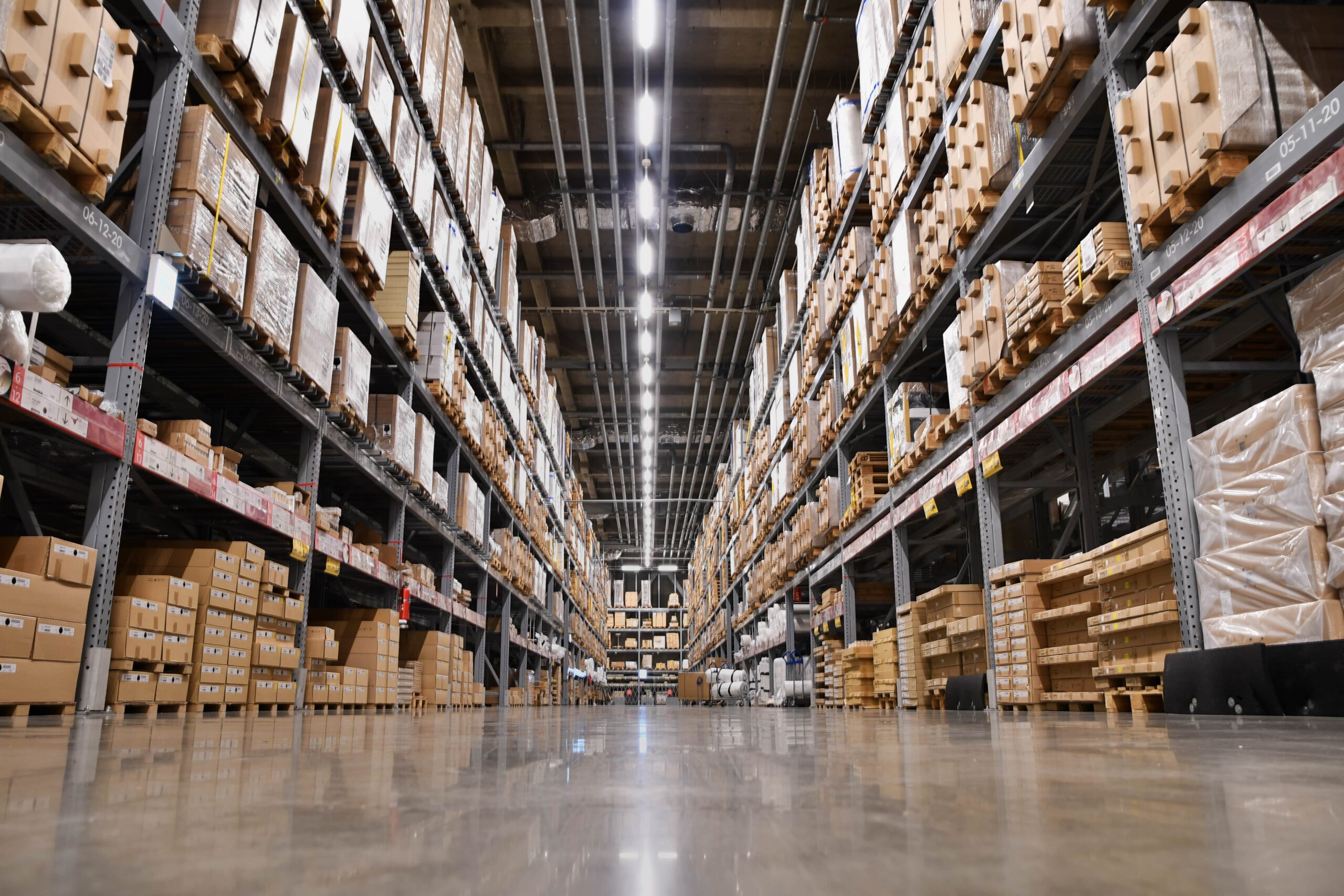Warehouse usage plays a key role in your ecommerce profitability as it determines how much inventory you can stock at a time and how much you’re spending on storage. Making the most of available storage space allows you to store more inventory and have more items available for sale. Moreover, warehouse utilisation is a factor that influences the efficiency of your warehouse operations.
This makes it crucial to calculate your warehouse space utilisation so you can keep costs low while boosting productivity and driving more revenue. In this guide, we walk you through the process of calculating space utilisation in your warehouse. We also provide you with actionable steps on warehouse space optimisation to improve your bottom line. Let’s get started.
What is warehouse space utilisation?
Warehouse space utilisation is a measure of how much space you’re utilising compared to the total storage capacity in your warehouse. It can be expressed either as a decimal number or a percentage and plays an important role in understanding warehouse performance. This metric helps you understand how efficiently you’re making use of available space, which has an influence on profitability and operating efficiency.
When your warehouse space utilisation is high, it means you’re making the most of your warehouse capacity. In other words, you’re minimising wasted space to store as much inventory as possible. On the other hand, if your warehouse space utilisation is low, it means you’re underutilising your warehouse capacity. You’re wasting valuable space and essentially paying for unused space.
Why is warehouse space utilisation crucial in ecommerce?
Improving your warehouse capacity utilisation is an essential step to improving your overall warehouse performance, which affects your bottom line. Here are some of the key benefits of good warehouse space utilisation.
Speedy order fulfilment
Optimising your warehouse usage requires optimising your warehouse layout and inventory shelving system. This improves inventory management and gives you better visibility into your inventory, which allows warehouse picking staff to quickly identify the items they need to retrieve. Moreover, workers are able to move seamlessly between aisles in a logical flow, which reduces transit time. As a result, you can enjoy better fulfilment efficiency and ensure that orders are fulfiled on time.
Reduced warehousing costs
High warehouse capacity utilisation means you’re making the most of your warehouse capacity and minimising wasted space. As such, you also reduce overhead costs associated with operating your warehouse and storing inventory.
Customer satisfaction
With more space to store inventory, you can have more units on hand and offer more product variety. This means you can prevent customer disappointment resulting from stockouts, helping you improve your customer satisfaction rates.
Increased revenue
Being able to offer more product variety and have more units in stock means you won’t miss the opportunity to make a sale. So you can effectively boost your sales, which will lead to increased revenue.
Common warehouse space utilisation challenges in 2023
Many warehouses don’t utilise even half of the capacity for storing inventory. That’s a lot of wasted space that you’re paying for, and a lot more potential sales that you’re losing out on. Unfortunately, businesses don’t realise that they need to calculate their space utilisation because they just don’t think there’s enough room.
In reality, your storage area is likely limited due to poor warehouse space management. Check out some of the common challenges that businesses face in managing their warehouse space.
Inefficient warehouse layout
A poorly configured warehouse setup is the leading cause of warehouse capacity issues. It’s likely that you have limited capacity because you’re using the wrong storage solutions and arranging them incorrectly. For example, you may be using up all your floor space and creating narrow aisles by utilising only horizontal racking systems when you could be using the vertical space to store more products while simultaneously increasing aisle width.
Unprepared for seasonal demands
If you didn’t plan ahead for seasonal demand changes, it’s likely that you’ll have to deal with overstock issues and an overcrowded warehouse. With all your last-minute inventory replenishment orders taking up space in an already-stocked warehouse, you’ll end up with warehouse storage issues that can negatively impact operational efficiency.
Outdated training and protocols
You may experience issues with warehouse capacity if you’re still relying on training and protocols from years before. Odds are that your business has grown over time and your warehouse has implemented new storage solutions or added new storage locations to accommodate that growth. However, your workers might not have the proper training to manage those changes and additions, which not only limits available space but also creates warehouse safety risks.
Lack of warehouse technology
In some cases, the lack of proper warehouse technologies is the only thing preventing businesses from making the most of their warehouse space. For starters, you may be unable to optimise your space utilisation because you lack the inventory visibility provided by a warehouse management system. Similarly, you may be unable to make use of vertical space because you lack the necessary warehouse material handling equipment.
Warehouse space utilisation formula and calculation
You can perform a warehouse space utilisation calculation using the following formula.
Warehouse Space Utilisation (%) = (Used Space / Total Available Space) x 100
So you need two important metrics before you can make your warehouse space calculation. These are:
Used space – This metric measures the total space used for storing inventory. It can be calculated by adding up the volume of all the inventory stored in your warehouse, which will give you your inventory cube size.
Total available space – This metric measures the total warehouse capacity. It can be calculated by measuring the total floor area in square feet and subtracting any space that can’t be used for storage such as restrooms and office space. Multiplying the number by the building’s clear height will give you your total warehouse capacity in cubic feet.
Let’s say you’re operating a warehouse with a storage capacity of 500,000 cubic feet and storing 80,000 cubic feet of inventory. Using the warehouse space utilisation formula, you can make the following calculation.
Warehouse Space Utilisation (%) = (80,000 / 500,000) x 100
= 0.16 x 100
= 16%
9 strategies to optimise warehouse space utilisation
If your warehouse space utilisation rate is on the lower end, it means that you’re not making the most of your warehouse capacity. Here are a few strategies to improve warehouse space utilisation.
1. Improve warehouse layout
Closely examine your existing warehouse layout to see how you can optimise it and maximise storage capacity. For example, you can reduce aisle width or make a few changes to your door placement to optimise how much space is utilised. It’s essential to design your layout considering the logical flow of goods so storage locations are assigned accordingly.
Make use of your warehouse management to gain better visibility over inventory movement in your warehouse. This can inform how to optimise the layout of your equipment and workstations to improve space utilisation.
2. Use vertical space
Vertical space is valuable real estate in ecommerce warehouses. Make the most of available overhead space by utilising vertical storage systems and mezzanine floors. That way, you can get more out of your total warehouse capacity without taking up the entire floor space.
3. Adopt cross-docking
Cross-docking minimises the need to store inventory as received goods are immediately loaded onto outbound vehicles for fulfilment. Adopting this strategy whenever possible will reduce the amount of inventory that needs to be assigned to storage locations. Instead, you can make the most of available space to store inventory that needs to be stored for a longer period of time.
4. Acquire a warehouse management system
A warehouse management system helps you manage your inventory more effectively to improve your space utilisation. It provides you with real-time inventory tracking and helps you perform inventory cycle counts so you can maintain accurate inventory levels and minimise the risk of stockouts. Demand forecasting capabilities further help you understand your inventory needs, which allows you to accurately plan your replenishment orders to avoid overstocking.
5. Consolidate warehouse locations
Creating separate spaces for different warehouse activities may help you organise your processes, but it could also take up valuable storage space in your warehouse. Consolidating some of your warehouse areas can improve your warehouse space utilisation. This might involve combining your receiving and shipping docks to free up space for storage. Consolidating your warehouse locations also improves warehouse efficiency by streamlining the flow of activities and minimising travel time.
6. Build a warehouse slotting strategy
Inventory slotting involves creating strategic storage locations for products based on shared characteristics, handling requirements, or demand patterns. Having the right warehouse slotting strategy is crucial to making the best use of available space and improving operational efficiency.
For example, you may want to store high-demand items closer to the packing area, so your picking staff won’t have to carry them around while picking other items. Meanwhile, you could reserve bulk storage areas in less accessible parts of the warehouse to store items that are low in demand.
Similarly, you could organise SKUs by the type of storage needed and the equipment required. This would involve assigning a separate area each for items that need to be stored in racks, cartons, and shelves. It would also involve creating a separate area for items that need to be moved using carts, pallet jacks, and forklifts.
7. Regularly audit your inventory
A regular audit of your warehouse and inventory is essential to identify problem areas, ensure inventory accuracy, and craft an optimisation strategy. Performing a complete warehouse audit will help you assess how your inventory is currently stored and whether there are any opportunities for improvement.
For example, the audit process may reveal broken shelving systems that you’re unable to utilise for storing inventory. In this case, repairing or replacing those systems could help you improve your space utilisation to a significant extent.
The audit process will also include an inventory audit, which is crucial for ensuring inventory accuracy and identifying inefficiencies. During the audit, you may be able to identify opportunities to remove deadstock and slow-moving inventory to make room for more profitable SKUs.
8. Purchase a demand forecasting system
Inaccuracies in your demand forecasting are the leading cause of stockouts and overstocking, which can impact your warehouse space utilisation. Invest in a demand forecasting system that can accurately make predictions about future demand by combining relevant data points including historical sales and demand trends. That way, you can plan your inventory replenishment accordingly and ensure that you’re making the most of available space to stock up on items that you need.
Many warehouse management systems come with built-in demand forecasting capabilities. These systems can make highly accurate predictions since they also serve as a central location for all your inventory and sales data.
9. Use automated storage and retrieval systems (AS/RS)
You can also make use of automated storage and retrieval systems (AS/RS) to optimise your warehouse space utilisation. There are a number of solutions in the market including horizontal and vertical carousels and vertical lift modules that can help you get more out of your warehouse space. These solutions can help you reclaim unused vertical space, make more efficient use of floor space, and increase inventory storage density meaning that you can significantly increase space utilisation.
Unlock warehouse magic with ShipBob’s WMS
The right warehouse technology, particularly warehouse management systems, holds the key to solving your biggest warehouse space utilisation challenges. Look to comprehensive solutions such as ShipBob’s WMS to improve inventory visibility and gain better control over your warehouse utilisation.
Real-time inventory tracking
ShipBob’s WMS provides you with real-time inventory tracking so you can always keep an eye on your inventory movement and stock levels. This gives you better visibility into where each item is as it moves through each stage of the warehouse process. It also helps you monitor how many units you have left of each item.
This level of visibility enables real-time inventory management and gives you better control over your warehouse usage. You’ll be able to closely monitor when you’re running low on stock and how many units you need to reorder. This enables you to keep your warehouse well-stocked at all times so you’re making the most of available storage space. Moreover, you can easily identify areas in which there are backlogs or inefficiencies, helping you make improvements to enhance space utilisation.
Advanced analytics
The WMS comes with powerful analytics to give you a comprehensive understanding of your warehouse performance. You can use the analytics dashboard to view relevant metrics on your warehouse productivity, SKU-level inventory performance, and logistics costs. This helps you get a clear idea of how much you’re spending on inventory storage, which SKUs are high in demand, and which SKUs are slow to sell. You can then combine these insights to make strategic decisions on warehouse space optimisation.
Integration capabilities
Many warehouses are hesitant to make the move from legacy systems because of the risk of losing their valuable data. ShipBob offers a vast range of integration options to ensure the safety of your data and legacy systems. The WMS seamlessly integrates with your existing technology so you can enjoy optimised warehouse management without losing your existing data.
“It turns out that ShipBob’s WMS was exactly what we needed. The beautiful thing about it is everything was connected. I could log on to our ShipBob account and see everything in one place, no matter if I’m looking at our facility in Kankakee, IL, or the ShipBob fulfilment centres in Canada or Europe. It was all the same system. I didn’t have to learn various different platforms or deal with support representatives at different companies.”
Adam LaGesse, Global Warehousing Director at Spikeball
Global scalability
ShipBob’s next-gen 3PL services can support your warehousing needs as you expand your business globally. You can take a hybrid fulfilment approach by leveraging our global network of fulfilment centres to streamline your international deliveries while optimising your in-house fulfilment with our cloud-based WMS. This allows you to maximise your in-house storage space since you’re storing some of your inventory strategically across different fulfilment centres.
User-friendly interface
The best part about ShipBob’s WMS is the user-friendly interface that anyone can understand with just a few minutes of training. This allows you to easily onboard new and temporary staff while keeping your error rates low. So you can implement the new system with minimal downtime.
“Our old system had 2 people we trusted to ship, since otherwise there were too many errors with the complexities. Now anyone can do it! We brought in 5-6 friends on a large order day, and they were pulling carts and picking orders within 5 minutes without any errors.”
Rick Corbridge, COO at Infuze Hydration
Get started with ShipBob WMS
Want to learn more about how to leverage ShipBob’s WMS to improve warehouse space utilisation in your facility? Get started by connecting with our team.
Warehouse space utilisation FAQs
We’ve answered some of the most common questions and queries about warehouse space utilisation.
Why is optimising warehouse space utilisation important for my ecommerce business?
Optimising warehouse space utilisation allows you to store more inventory, which helps you avoid stockouts and allows you to expand your product variety. It also reduces overhead costs, which eventually contributes to your bottom line.
How can I calculate my current warehouse space utilisation?
You can calculate your warehouse space utilisation by determining your used space and dividing it by the total available space.
How much should I pay for warehouse space?
According to Statista, warehouse space cost $11.50 per square foot in 2022. Depending on your required warehouse space, expect to pay around $11-12 per square foot.
Can I outsource my warehousing needs to ShipBob?
Yes! ShipBob offers outsourced warehousing solutions where you ship your inventory to our fulfilment centres and we take care of your inventory and warehouse management.



